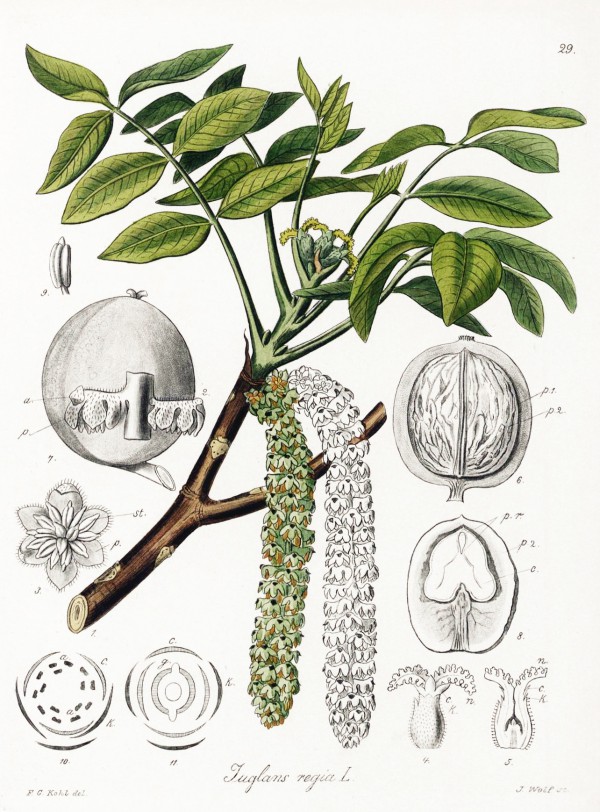Dies ist eine alte Version des Dokuments!
Juglans regia L. - Juglandaceae - (Persian, English, common) walnut, Echte Walnuss, Walnuß
Large deciduous tree, native to Europe and Asia.
„The male flowers are in drooping catkins 5-10 cm long, and the female flowers are terminal, in clusters of two to five, ripening in the autumn into a fruit with a green, semifleshy husk and a brown, corrugated nut.“
http://en.wikipedia.org/wiki/Juglans_regia
The leaves (walnut leaf, Juglandis folium) and the fruit husks (Juglandis fructus cortex) are used as astringend and diarrhoeal. „The value of walnut leaf to treat skin orders is mainly ascribed to the tannins (astringent, anti-inflammatory, antimicrobial) but also to juglone and germacrene D, all of which have antimicrobial activity.“
[Medicinal Plants of the World. Ben-Erik Van Wyk and Michael Wink, Pretoria 2004, 183]
„[Walnuts] are ripe when the green fleshy sheath is split open, loosen the nuts from the shell, and falling to the ground. Usually, the nuts are shaken from the trees, swept into rows, collected and brought to first cleaning and subsequent drying.“
http://de.wikipedia.org/wiki/Echte_Walnuss
Main volatile compounds identified from walnut headspace via GS-MS were myrcene (13%), farnesene (13%), limonene (9%), (E)-ocimene (8%), caryophyllene (8%), caryophyllene oxide (4%) and sabinene (4%).
[Response to walnut olfactory and visual cues by the parasitic wasp Diachasmimorpha juglandis., Henneman, M.L., Dyreson, E.G., Takabayashi, J., Raguso, R.A., Journal of chemical ecology, Vol.28(11), 2002, 2221-2244]
„The aroma volatiles of walnuts from three different geographical locations were studied. Over 110 compounds were identified in the headspace volatiles, many for the first time as walnut components. Walnuts from China and the Ukraine contained high levels of lipid-derived volatiles, in particular hexanal, pentanal, 1-hexanol and 1-pentanol from linoleic acid breakdown, and 1-penten-3-ol from α-linolenic acid breakdown. Chilean walnuts, however, contained high levels of alkylbenzenes of molecular weight 120, with the lipid-derived aldehydes and alcohols present at much lower levels than in the other two walnut samples.“
[Analysis of the headspace aroma compounds of walnuts (Juglans regia L.)., Elmore, J.S., Nisyrios, I., Mottram, D.S., Flavour and fragrance journal, Vol.20(5), 2005, 501-506]
Important volatiles of walnut oils (pressed from roasted walnuts) were typical roasting products like furfural (1.3-12.5%), 2-methylpyrazine (0.6-1.8%), dimethylpyrazines (0.3-2.2%), furfurylalcohol (0.5-3.3%), furthermore acetic acid (18.6-42.2%), hexanal (6.6-31.8%), and (E)-2-hexenal (tr-0.4%).
[Bail, Stefanie, et al. „Characterization of volatile compounds and triacylglycerol profiles of nut oils using SPME‐GC‐MS and MALDI‐TOF‐MS.“ European journal of lipid science and technology 111.2 (2009): 170-182]
„The chemical composition of volatile extract of Pakistani cultivar of walnut [ground nuts] was investigated using Gas Chromatography-Mass Spectrometery (GC-MS) analysis… Some volatiles e.g. α-thujene, sabinene, p-cymene, 1,8-cineol, linalool, myrtenal, pinocarveol, verbenol, myrtenol, p-cymen-8-ol, isobutyl cyanide and benzyl alcohol have already been reported from walnut while the remaining constituents namely α-cadinol, α-bisabolol, isopulegol, carvacrol, estragol, globulol, viridiflorol, nerolidol, and neo-iso-3-thujanol are reported for the first time from this species.“
[Investigation on the volatile constituents of Juglans regia and their in vitro antioxidant potential., Abbasi, M.A., Raza, A., Riaz, T., Shahzadi, T., Aziz-ur-Rehman, J.M., Shahwar, D., Ahmad, N., In Proceedings Royal Society Queensland, Vol.47, 2010, 137-41]
http://www.paspk.org/proceedings/47%20No.%203/e27c51d2proc47-3-2.pdf
The main volatile component of walnut leaves was germacrene D (0.5ppm). Other major volatiles identified include caryophyllene, (E)-β-ocimene, β-pinene, and limonene.
[Buttery, Ron G., et al. „Identification of germacrene D in walnut and fig leaf volatiles.“ Journal of Agricultural and Food Chemistry 34.5 (1986): 820-822]
Walnut oil is obtained from the seeds (of unripe nuts picked from the tree) by hydraulic pressing and is rich in polyunsaturated fatty acids.
„Similar to olive oils, in walnut oils the most abundant group of volatiles was the aldehydes and hydrocarbons. n-Pentane (8.84-19.46%) was the principal component in all varieties, followed by 2,4-decadienal and nonanal. Unlike olive oils, the walnut oila contained significantly higher amounts of pentanal and hexanal. Other aldehydes and alcohols were produced and formed an important fraction of volatiles in walnut oil of the variety Criolla. Furthermore, 2-hexanone, 2-pentylfuran, and 2-octylfuran were present only in this variety.“
[A multivariate study of the relationship between fatty acids and volatile flavor components in olive and walnut oils., Torres, M.M., Martínez, M.L., Maestri, D.M., Journal of the American Oil Chemists' Society, Vol.82(2), 2005, 105-110]

Kohl, F.G., Die officinellen Pflanzen der Pharmacopoea Germanica, t. 29 (1891-1895)
http://www.plantillustrations.org/species.php?id_species=567951
Juglans regia
© Rolf Marschner (2006),
www.botanische-spaziergaenge.at
